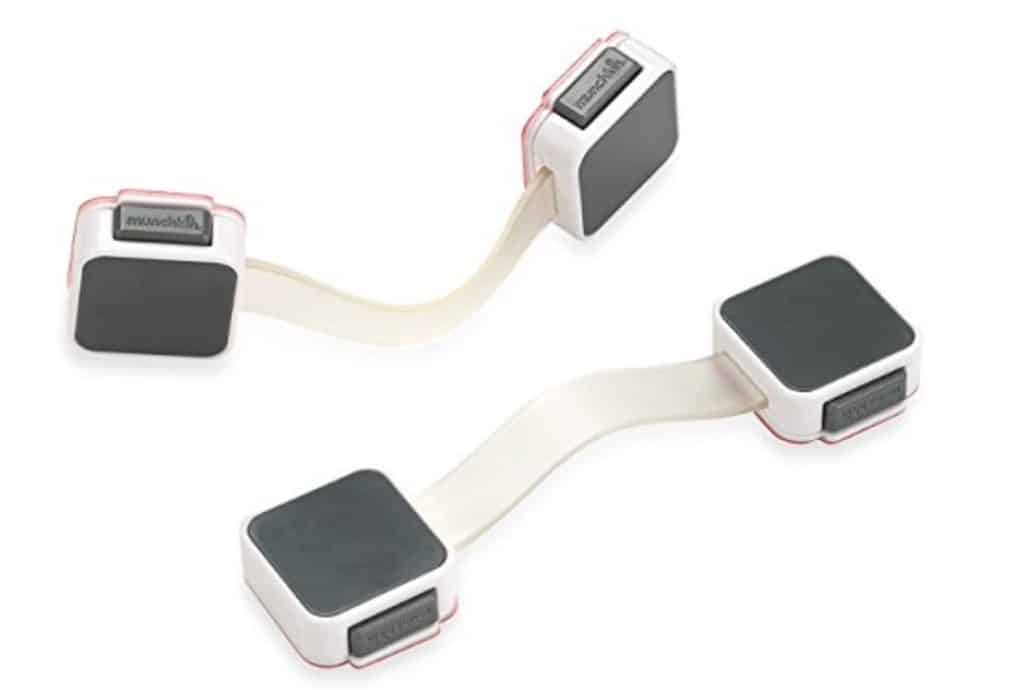If you have a baby crawling around your house you know that baby-proofing is a must-do. One of the most important pieces of baby-proofing equipment is cabinet locks.
What Are Cabinet Locks?
Sometimes known as “draw locks” or “cabinet latches,” these simple devices prevent children from opening cabinets while making it relatively easy for the rest of the family to get inside.
Cabinet looks will either stick to a cabinet with adhesive (this is good for coated cabinets, but not for hardwood) or they will lock around your existing cabinet handles. The handle method can be easy but also limiting, depending on the size and shape of your cabinet pulls/handles.
One thing to keep in mind with the adhesive variety is that they can pull off paint or coatings. The adhesive will be in place for extended periods of time, sometimes multiple years so it can harden over time and become hard to remove. If you or your child tugs it in the wrong way it can rip coating right off a cabinet. Look for adhesive from 3M (some brands say who makes theirs or it’ll say on the latch’s back sticker), as their formulation is usually reliable and will hold up well over time.
While they are called “cabinet locks” they also work on ovens, microwaves, and toilets. You can use them for doors, but they typically aren’t as strong as a good door latch.
What Latch Features To Look For
If you are shopping for cabinet locks, what should you be looking for? Here’s our checklist:
- Affordable – Depending on your kitchen and bathrooms, plus the areas where you spend time with your baby, you might need a lot of these. As a result, they should be relatively cheap
- 3M adhesive – As mentioned above, if you are using a stick-on latch then you are going to want one that has the smallest possible chance of damaging your cabinets
- Easy opening – A good latch will be secure enough to stop a persistent baby or toddler, but easy for adults to open
- Nice design – Let’s face it, these little piece of plastic are going to be part of your decor for a few years, they should not be eyesores
Best Cabinet Latches
Here’s our list of our favorites. After having kids we’ve gone through a lot of these!

Munchkin Xtraguard Dual-Action Latches
These Munchkin Xtraguard locks are the best sold today. They are most expensive than most of the competition, but they make up for that with a number of strengths. These are secure, they look OK, they are easy to open for adults, and they are basically impossible for anyone under 4 to open.
These Munchkin latches also use a good adhesive. We’re not sure if it’s 3M (it probably isn’t) but they we’ve been able to remove these and reuse them with 3M Command adhesive multiple times.
These Munchkin latches are called “dual-action” because they require two buttons to be pressed in a pinching manner in order to remove them. This action is really hard for children’s hands, even strong kids, but easy for adults. Interestingly, they are dual-action in another way: either side of the latch can be opened up, which is another nice perk.
I’ve used these through two kids, for multiple years, with no damage to my cabinets, and no break-throughs until the kids were around 4 years old. They aren’t super, super secure, which allows adults to get into them easily, but it does mean your kids will figure them out before they get too old. Even so, I’ve been quite happy with them and think they are a great pick.
Cabinet Locks Tips
How do I install cabinet locks?
Most cabinet locks use adhesive (stickers) to stick onto the outside of a cabinet. You will always want to clean and then fully dry the surface before applying the adhesive. This will help ensure a good adhesion. After sticking them on, you’ll want to press firmly for at least 10 seconds. After that give the adhesive about 24 hours to cure and reach its full strength.
How do I remove cabinet locks?
This can be challenging, especially if you have an old adhesive or one from a cheaper brand. The best way to remove the adhesive sticker is to get a hard piece of plastic, like a credit card, and scrape down the surface of the door or cabinet while pulling gently on the lock. Be careful not to pull too hard as you can pull the paint right off your cabinets. A little rubbing alcohol or similar solution can help loosen the adhesive if you have some lying around.
